![]()
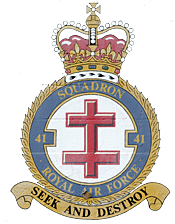 Although
its time at Wattisham was brief, 41 Squadron commands an impressive history
throughout the lifespan of the RFC and RAF, and is one of the few squadrons
still active today in East Anglia.
Although
its time at Wattisham was brief, 41 Squadron commands an impressive history
throughout the lifespan of the RFC and RAF, and is one of the few squadrons
still active today in East Anglia.
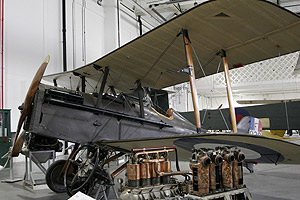 Almost
stillborn, 41's first appearance came on 15 April 1916 when it was formed
from a nucleus of 28 Squadron. However, disbandment came within six weeks,
as it was renumbered 27 RS. Formed for a second time on 14 July 1916 again
at Gosport, during the Great War it used FE8s, DH5s and SE5as on the Western
Front for fighter and escort duties. It was from this time that the squadron's
famous badge would be later adopted, that of a double-armed cross, approved
by HRH King George VI in February 1937. The badge originated from the
Squadron's association with St Omer, France, the cross being part of the
town's arms. On return to the UK at Tangmere on 7 February 1919, the unit
was disbanded on the last day of the year, another victim of the post-war
haste to reduce aircraft numbers and pilots.
Almost
stillborn, 41's first appearance came on 15 April 1916 when it was formed
from a nucleus of 28 Squadron. However, disbandment came within six weeks,
as it was renumbered 27 RS. Formed for a second time on 14 July 1916 again
at Gosport, during the Great War it used FE8s, DH5s and SE5as on the Western
Front for fighter and escort duties. It was from this time that the squadron's
famous badge would be later adopted, that of a double-armed cross, approved
by HRH King George VI in February 1937. The badge originated from the
Squadron's association with St Omer, France, the cross being part of the
town's arms. On return to the UK at Tangmere on 7 February 1919, the unit
was disbanded on the last day of the year, another victim of the post-war
haste to reduce aircraft numbers and pilots.
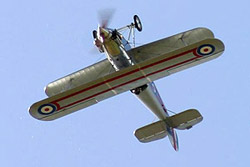 Re-formed
on 1 April 1923 at Northolt, 41 Squadron consisted of a single flight
of Sopwith Snipes, re-equipping a year later with the Siskin. Bulldogs
followed in October 1931. Twelve years of occupation of the London airfield
ended in October 1935 when the squadron was posted to Aden for policing
duties in the Italian-Abyssinian War. Flying Hawker Demons from Khormaskar,
bombs were dropped on dissident villages. 41 left to return to the UK
in August 1936, settling at Catterick. The elegant Hawker Fury replaced
the two-seat Demons a year later.
Re-formed
on 1 April 1923 at Northolt, 41 Squadron consisted of a single flight
of Sopwith Snipes, re-equipping a year later with the Siskin. Bulldogs
followed in October 1931. Twelve years of occupation of the London airfield
ended in October 1935 when the squadron was posted to Aden for policing
duties in the Italian-Abyssinian War. Flying Hawker Demons from Khormaskar,
bombs were dropped on dissident villages. 41 left to return to the UK
in August 1936, settling at Catterick. The elegant Hawker Fury replaced
the two-seat Demons a year later.
1939 saw 41 convert to the Spitfire at Catterick. The early war years saw the station used for resting squadrons from front-line duty on the south coast, and for re-equipping with new pilots and aircraft. Fighter cover was also provided for the north-east and for convoys in the North Sea, but action was much lighter than in the hectic skies over Kent and Essex. The Battle of Britain saw 41 Squadron see-saw between airfields in the north and south, with detachments to Hornchurch being a regular haunt. Tragedy struck not just the pilots, but also the ground crew - on 18 October 1939, Whitley K8996 of 102 Squadron crashed on take-off from Driffield, whilst conveying men and stores of 41 from Catterick to Drem. Seven were killed and two injured, a result of the aircraft being too heavily laden.
41's greatest hours were during the Battle of Britain, when it formed the vanguard of the defence of the country against Hitler's Luftwaffe. Based at Biggin Hill and primarily Hornchurch, the squadron was in the thick of the battle for most of the time. Typical of such times was 28 July, when 41 Squadron found itself against Jagdeschwader 51 and Major Werner Molders, who was wounded in the action. At the zenith of the battle, on 15 September, 41 were still in the frontline. Engagements on the enemy were made throughout the day, attacking Dornier 17Z and Heinkel 111 formations, all without the loss of Spitfires or pilots. With claims of over ninety enemy aircraft destroyed 41 was one of the highest scoring squadrons of the Battle of Britain. One pilot, Pilot Officer Eric Lock, was credited with twenty-six kills by the time he was lost in action on 3 August 1941.
After the Battle was won, 41 turned its attention to escorting light bombers on attack raids into France. Known as 'Circus' raids, many were made without loss during early 1941. A move to Merston and a change to the MkVb Spit enabled longer-range 'Rhubarb' low-level sweeps over France to be a facet of 41's repertoire for the next few years, together with escorting bomber missions.
 Hawkinge
in Kent was the home in late 1942, where 'Rhubarb' and 'Rodeo' missions
over France were regularly made. August brought Operation 'Jubilee', the
combined operation at Dieppe, in which 41 would play a major part. 19
August saw 41 heavily involved in providing top cover for the Canadians
of 412 Squadron and the Hurri-bombers of 175 Squadron, during which the
unit had five Spitfires hit, including the loss of the OC, Sqn Ldr Hyde.
September 1942 brought a brief stay of rest at Eglinton in Northern Ireland.
Hawkinge
in Kent was the home in late 1942, where 'Rhubarb' and 'Rodeo' missions
over France were regularly made. August brought Operation 'Jubilee', the
combined operation at Dieppe, in which 41 would play a major part. 19
August saw 41 heavily involved in providing top cover for the Canadians
of 412 Squadron and the Hurri-bombers of 175 Squadron, during which the
unit had five Spitfires hit, including the loss of the OC, Sqn Ldr Hyde.
September 1942 brought a brief stay of rest at Eglinton in Northern Ireland.
Conversion to an improved mark of Spitfire, the Griffon-engined MkXII, was accomplished at High Ercall in Salop during 1943, after transferring from Llanbedr. In an effort to counter raids in the South by FW190s and Me109s, 41 was moved to Hawkinge in Kent, and later Friston in East Sussex, although the grass airfield was not really suitable for the heavier Spit. Action was made during April to June, when numerous attacks by bomb-wielding FW190s were repelled by 41.
Returning to Friston in March 1944, 41 found the airfield just as unsuitable as before, losing an aircraft on landing. Still flying the MkXII, modified for 'Rhubarb' bombing missions, the unit transferred to Bolt Head in Devon in April 1944. Intended for the ground-attack role during the D-Day offensive, a change of role was swiftly made in the face of the V1 'Doodlebug' attacks on London, as the squadron was rushed to West Malling to counter the rocket attacks on the capital, the Griffon powered MkXII being one of the few piston-engined fighters capable of catching the V1.
Towards
the end of 1944 sweeps over the continent were made from Lympne in Kent,
conversion to the more powerful Mk XIV enabling recce patrols to be established
to counter the Me262 jet menace now troubling the 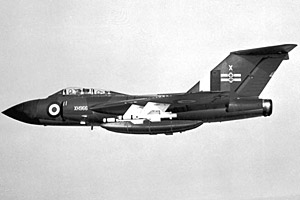 American
daylight bombing fleet. December saw the squadron push forward to Belgium,
and early 1945 to Celle in Germany. Here the Spitfires joined with Russian
Yak fighters in daily dogfights against FW190s until the end of the war.
Tempests replaced the Spits in September 1945, but on 1 April 1946 41
renumbered as 26 Squadron and 122 Squadron at Dalcross became the new
41, back with Spitfire FXXIs.
American
daylight bombing fleet. December saw the squadron push forward to Belgium,
and early 1945 to Celle in Germany. Here the Spitfires joined with Russian
Yak fighters in daily dogfights against FW190s until the end of the war.
Tempests replaced the Spits in September 1945, but on 1 April 1946 41
renumbered as 26 Squadron and 122 Squadron at Dalcross became the new
41, back with Spitfire FXXIs.
15 April 1946 saw the squadron move its Spitfire XXIs to Wittering, before a move to Church Fenton in mid-April the following year and conversion to the twin-engined de Havilland Hornet. Here they stayed for some four years before relocating to Biggin Hill on 29 March 1951, and re-equipping with Gloster's venerable Meatbox. Conversion to the Hunter followed in June 1955 and runway extension carried out in 1957, but the confines of the base were all too apparent, so disbandment for 41 came on 16 January 1958 and its number given to the existing 141 Squadron at Coltishall.
Renumbered at RAF Coltishall from 141 Squadron on 16 January 1958, its Javelin Mk 4s moved to Wattisham in the June. The venerable Mk4s were replaced with Mk 8s in July 1960. A detachment to Leconfield was made in 1959 when six Vautour 2Ns of EC 30 were at the base, the unit staying until September 1960 while runway work was undertaken at its Suffolk home. Disbandment came in December 1963.
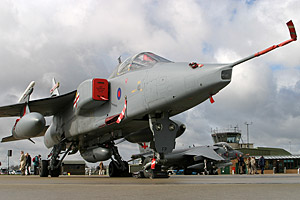 A
brief period as a Bloodhound air-defence missile unit at West Raynham
during the late sixties was followed as a Phantom unit at Coningsby for
four years, flying the FGR2 version of McDonnell-Douglas' phinest. Tasked
with the recce role, it re-formed at the Lincolnshire base on 1 April
1972. Conversion to the Jaguar was undertaken in 1977 as the Phantoms
moved from the ground-attack/recce role to air defence, replacing the
Lightning as the UK's first line defence fighter. With the change of aircraft
came a change in base, the squadron returning to Coltishall on 1 April
from where it had flown the Javelin back in the fifties.
A
brief period as a Bloodhound air-defence missile unit at West Raynham
during the late sixties was followed as a Phantom unit at Coningsby for
four years, flying the FGR2 version of McDonnell-Douglas' phinest. Tasked
with the recce role, it re-formed at the Lincolnshire base on 1 April
1972. Conversion to the Jaguar was undertaken in 1977 as the Phantoms
moved from the ground-attack/recce role to air defence, replacing the
Lightning as the UK's first line defence fighter. With the change of aircraft
came a change in base, the squadron returning to Coltishall on 1 April
from where it had flown the Javelin back in the fifties.
Resident
at Coltishall for some twenty-three years, the cross of St Omer was a
very familiar sight around the Norfolk countryside. Operational honours
were again awarded for the squadron's involvement in Desert Storm in 1991,
as part of the Jaguar Detachment (JagDet) combined unit. As a result of
the war, after returning from the Gulf, the Jaguar wing deployed to Incirlik,
in south-west Turkey, to participate in Operation WARDEN, providing an
air presence necessary to secure a safe haven for the Kurdish people of
Northern Iraq. This commitment was handed over to the Harriers in April
1993 to be replaced less than four months later by a similar role in support
of Operation DENY FLIGHT, policing the skies above the Bosnian conflict
from a base in Southern Italy. It was during this period of operations
that a 41(F) Jaguar became the first RAF aircraft to drop a bomb in anger
over Europe since 1945. This attack was carried out against a Bosnian
Serb tank, and resulted in the tank being severely damaged. Since then,
detachments overseas have been a regular feature of squadron life, supporting
the various UN operations in the troublespots around the world. In 1996,
the squadron became the first RAF unit to visit Egypt since the Suez crisis
of 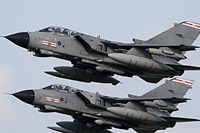 1956.
1956.
41(F) Squadron disbanded as a Jaguar unit on 31 March 2006 as part of the draw-down of the Jaguar force. It reformed the next day at RAF Coningsby as the Reserve squadron numberplate for the Fast Jet & Weapons Operational Evaluation Unit (OEU), flying the Harrier GR9, Tornado GR4 and F3. Ironically the OEU disposed of its Jaguars just before, as the evaluation role for the aircraft had been fulfilled.